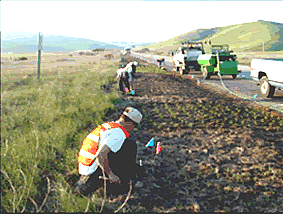Roadside Management Toolbox: Native Vegetation


What is This Treatment
Native vegetation is naturally occurring plant materials existing in California prior to European settlement. Ongoing research has shown that certain species of native plants can function in the harsh environment of the roadside and over time when conditions are favorable to the native vegetation can out-compete weeds and annual grasses which require extensive maintenance to manage.
When to use This Design Concept?
Native vegetation is best suited for transition, rural and natural areas. Selection of appropriate native plant material for a specific location is crucial and varies considerably based on the site’s microclimate. Consult with the District Landscape Architect, District Biologists and District Maintenance Landscape Specialists for assistance in designing a native roadside treatment. Construction techniques and proper sequencing are critical for success in establishing natives. Among the many things to address are: topsoil and duff preservation, pre and post construction weed control, timing and planting techniques, length of establishment period and long term maintenance activities.
Benefits
- Natives enhance roadside environment, water quality, and roadside visual quality.
- If selected correctly and properly established native plants are self-sustaining, surviving and thriving on naturally occurring rainfall and soil nutrients.
- Native plant materials generally require less maintenance than ornamental/non-native plants due to slow growth patterns, competition with other plants and little if any irrigation requirements.
Limitations
- Site specific management techniques are required to establish and maintain native plant material.
- Pre-construction site preparation is essential and requires additional contract resources.
- A minimum of one full season of plant establishment using adaptive management techniques is required and most native plants will not become fully established for 3 to 5 years. Research to determine the most effective methods to install and establish native plant material is currently under way.
- Due to earthwork and compaction, the soil structure of the roadside area following construction activities may not support native plants unless remedial measures are taken.
- Most native plants are not aggressive and may require assistance through herbicides or other vegetative controls during an establishment period to out-compete more aggressive invasive plants and weeds
Specifications
- Use Standard Specifications section 20, and section 20 Standard Special Provisions(SSPs).
Cost
- Native sod - $5.40 -$9/yd2 includes cultivation(currently a developing technology with limited availability).
- Plug planting - $3.60-$5.40/yd2 includes cultivation(large amount of hand labor required, effective for small areas).
- Drill seeding - $.90-$1.80/yd2 includes cultivation(recommended for large roadside areas with slopes <1:3).
- Hydroseeding - $1.80-$2.70/yd2 includes cultivation(for native plants, use only in areas with difficult access).
- Bees Item(s) – Multiple items
Updated May 24, 2012

